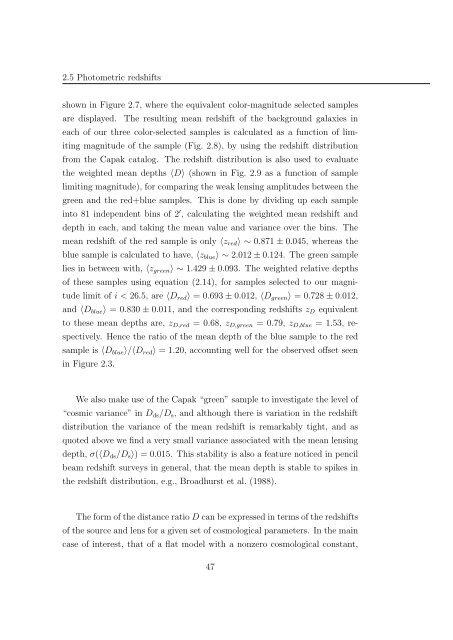Mass and Light distributions in Clusters of Galaxies - Henry A ...
Mass and Light distributions in Clusters of Galaxies - Henry A ...
Mass and Light distributions in Clusters of Galaxies - Henry A ...
Create successful ePaper yourself
Turn your PDF publications into a flip-book with our unique Google optimized e-Paper software.
2.5 Photometric redshifts<br />
shown <strong>in</strong> Figure 2.7, where the equivalent color-magnitude selected samples<br />
are displayed. The result<strong>in</strong>g mean redshift <strong>of</strong> the background galaxies <strong>in</strong><br />
each <strong>of</strong> our three color-selected samples is calculated as a function <strong>of</strong> limit<strong>in</strong>g<br />
magnitude <strong>of</strong> the sample (Fig. 2.8), by us<strong>in</strong>g the redshift distribution<br />
from the Capak catalog. The redshift distribution is also used to evaluate<br />
the weighted mean depths 〈D〉 (shown <strong>in</strong> Fig. 2.9 as a function <strong>of</strong> sample<br />
limit<strong>in</strong>g magnitude), for compar<strong>in</strong>g the weak lens<strong>in</strong>g amplitudes between the<br />
green <strong>and</strong> the red+blue samples. This is done by divid<strong>in</strong>g up each sample<br />
<strong>in</strong>to 81 <strong>in</strong>dependent b<strong>in</strong>s <strong>of</strong> 2 ′ , calculat<strong>in</strong>g the weighted mean redshift <strong>and</strong><br />
depth <strong>in</strong> each, <strong>and</strong> tak<strong>in</strong>g the mean value <strong>and</strong> variance over the b<strong>in</strong>s. The<br />
mean redshift <strong>of</strong> the red sample is only 〈z red 〉 ∼ 0.871 ± 0.045, whereas the<br />
blue sample is calculated to have, 〈z blue 〉 ∼ 2.012 ± 0.124. The green sample<br />
lies <strong>in</strong> between with, 〈z green 〉 ∼ 1.429 ± 0.093. The weighted relative depths<br />
<strong>of</strong> these samples us<strong>in</strong>g equation (2.14), for samples selected to our magnitude<br />
limit <strong>of</strong> i < 26.5, are 〈D red 〉 = 0.693 ± 0.012, 〈D green 〉 = 0.728 ± 0.012,<br />
<strong>and</strong> 〈D blue 〉 = 0.830 ± 0.011, <strong>and</strong> the correspond<strong>in</strong>g redshifts z D equivalent<br />
to these mean depths are, z D,red = 0.68, z D,green = 0.79, z D,blue = 1.53, respectively.<br />
Hence the ratio <strong>of</strong> the mean depth <strong>of</strong> the blue sample to the red<br />
sample is 〈D blue 〉/〈D red 〉 = 1.20, account<strong>in</strong>g well for the observed <strong>of</strong>fset seen<br />
<strong>in</strong> Figure 2.3.<br />
We also make use <strong>of</strong> the Capak “green” sample to <strong>in</strong>vestigate the level <strong>of</strong><br />
“cosmic variance” <strong>in</strong> D ds /D s , <strong>and</strong> although there is variation <strong>in</strong> the redshift<br />
distribution the variance <strong>of</strong> the mean redshift is remarkably tight, <strong>and</strong> as<br />
quoted above we f<strong>in</strong>d a very small variance associated with the mean lens<strong>in</strong>g<br />
depth, σ(〈D ds /D s 〉) = 0.015. This stability is also a feature noticed <strong>in</strong> pencil<br />
beam redshift surveys <strong>in</strong> general, that the mean depth is stable to spikes <strong>in</strong><br />
the redshift distribution, e.g., Broadhurst et al. (1988).<br />
The form <strong>of</strong> the distance ratio D can be expressed <strong>in</strong> terms <strong>of</strong> the redshifts<br />
<strong>of</strong> the source <strong>and</strong> lens for a given set <strong>of</strong> cosmological parameters. In the ma<strong>in</strong><br />
case <strong>of</strong> <strong>in</strong>terest, that <strong>of</strong> a flat model with a nonzero cosmological constant,<br />
47
















